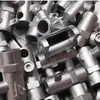Mobile:+86-311-808-126-83
Email:info@ydcastings.com
Innovative Techniques in Low Pressure Die Casting for Enhanced Metal Fabrication
Low Pressure Die Casting An Overview
Low pressure die casting (LPDC) is an advanced manufacturing process widely used in various industries for producing complex metal components with high precision and excellent surface finish. This method gained popularity due to its ability to create intricate shapes and details that other casting methods might struggle with. In this article, we will explore the principles of low pressure die casting, its advantages, applications, and some of the challenges associated with the process.
The Process of Low Pressure Die Casting
Low pressure die casting utilizes a unique method where molten metal is poured into a die at lower pressure compared to traditional die casting techniques. The process typically begins with the melting of the metal alloy in a furnace, which is then transported to the die casting machine. The key characteristic of LPDC is that the molten metal is injected into the mold under controlled low pressure — usually less than 1 bar (14.5 psi). This is achieved using a sealed chamber where the die is placed above the molten metal.
Once the metal is injected into the die, it fills the cavity through a bottom-up approach. The process allows for improved filling of the mold, reducing the risk of air entrapment and improving the overall quality of the cast part. After the molten metal solidifies, the die is opened and the component is ejected, completing the casting cycle.
Advantages of Low Pressure Die Casting
1. High Precision and Surface Finish LPDC enables the production of components with tight tolerances, smooth surface finishes, and reduced need for secondary machining. This characteristic is particularly beneficial in industries where precision is paramount, such as aerospace and automotive.
2. Enhanced Material Properties The low-pressure injection process results in a more uniform density and finer microstructure in the final product, which can lead to improved mechanical properties such as strength and durability.
3. Versatility with Alloys LPDC is compatible with a variety of metals, including aluminum, magnesium, and zinc alloys. This flexibility allows engineers to select the most appropriate material for their specific application based on cost, weight, and performance requirements.
4. Reduced Waste The process is efficient in terms of material usage. The controlled filling mechanism minimizes scrap metal, as any excess molten metal can be reused in subsequent casting cycles.
low pressure die casting

Applications of Low Pressure Die Casting
Low pressure die casting finds applications in numerous sectors, including
- Automotive Industry Key automotive components such as engine blocks, transmission housings, and wheel rims are commonly produced using LPDC due to their strength and weight advantages. - Aerospace Industry Components that require high precision and lightweight properties, such as brackets and housings, are often manufactured through this process.
- Consumer Electronics Many electronic devices utilize LPDC for creating housings and structural components that need to be both lightweight and robust.
- Medical Devices LPDC is also utilized in the production of medical equipment that necessitates high levels of precision and quality.
Challenges and Considerations
While low pressure die casting offers numerous benefits, there are some challenges to consider. The initial capital investment for LPDC equipment can be relatively high, making it less accessible for small-scale operations. Additionally, the design of the die must be meticulously planned to accommodate the low-pressure filling process, which may require specialized knowledge and expertise.
Furthermore, while LPDC enhances material properties, there are limitations in the range of wall thickness that can be achieved effectively. It is essential for designers to consider these factors when selecting the LPDC process for their applications.
Conclusion
Low pressure die casting is a highly efficient and precise manufacturing process that offers significant advantages for creating complex metal components across various industries. With its ability to produce high-quality parts while minimizing waste and maximizing material properties, LPDC is a preferred choice for manufacturers looking to innovate and improve their production capabilities. As technology continues to advance, low pressure die casting is likely to gain even more traction and relevance in the manufacturing landscape.
-
Why Should You Invest in Superior Pump Castings for Your Equipment?NewsJun.09,2025
-
Unlock Performance Potential with Stainless Impellers and Aluminum End CapsNewsJun.09,2025
-
Revolutionize Your Machinery with Superior Cast Iron and Aluminum ComponentsNewsJun.09,2025
-
Revolutionize Fluid Dynamics with Premium Pump ComponentsNewsJun.09,2025
-
Optimizing Industrial Systems with Essential Valve ComponentsNewsJun.09,2025
-
Elevate Grid Efficiency with High-Precision Power CastingsNewsJun.09,2025











